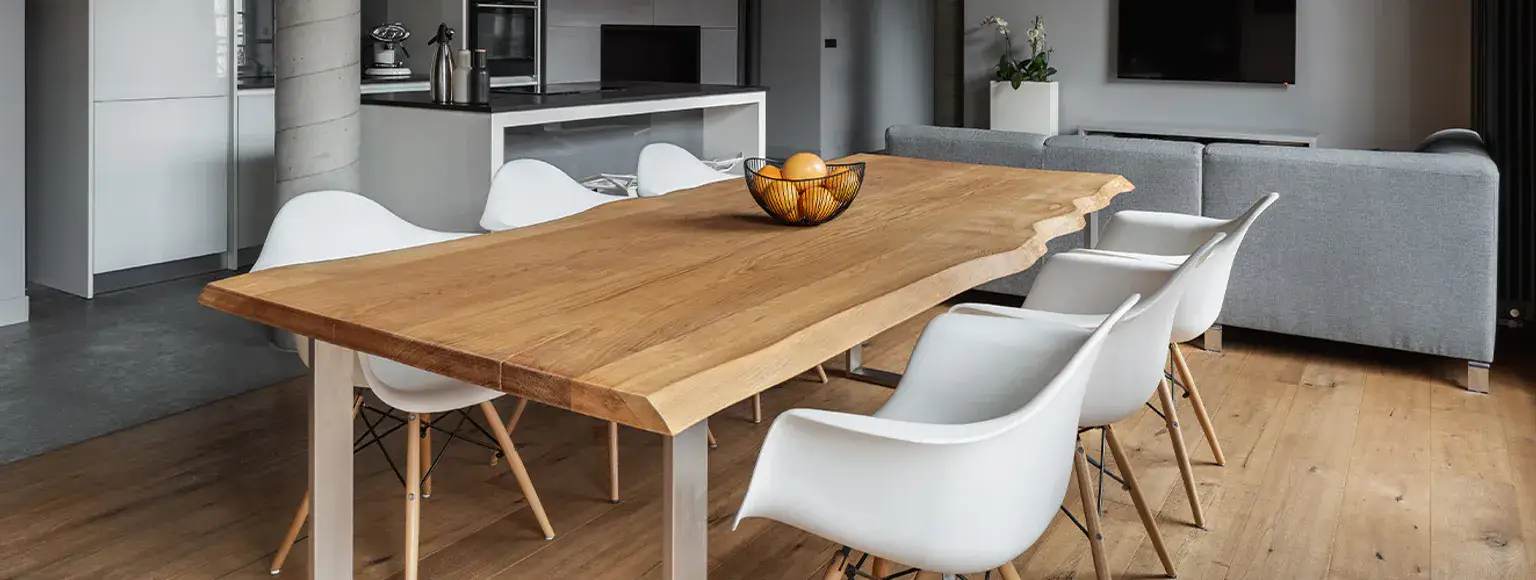A wooden table is something special, and each one is truly unique. If you own one, you want to enjoy it for as long as possible. However, this can only be ensured through proper care and attention. To help your wooden table maintain its shine, we have summarized all the necessary tips for you.
Why Proper Care Is So Important for a Wooden Table
Many tables – whether dining or writing desks – are made of wood and are an essential part of good interior design. What’s important: Every wooden furniture piece needs special care for long-term preservation. But why is this care so important?
Basically, the main goal is to continuously protect the wooden surface. So avoid scratches, impacts, moisture, and dirt. The use of wood oils and glazes brings out the natural beauty of your table. This also enhances the appearance and through regular oiling, the table maintains its shine. The treatment protects the table from drying out and annoying insect infestations. Through proper care, cleaning will be easier for you in the future. With an untreated table, stains and liquids penetrate the surface more quickly. Therefore, regular care is all the more important to make your work easier.
Note: Through treatment, dirt has less chance of penetrating the surface of the wood.

Oiling a Wooden Table – Here’s How
Before you devote yourself to caring for your table, it’s important to know what to look for, what steps to follow, and what matters in the process.
First, you should determine whether your wooden table is made of solid wood or laminated wood. At the same time, it’s important to know whether the table has already been treated or if it has an untreated surface. Untreated tables need more attention than pre-treated wooden tables. After determining that you have an untreated table, you can use suitable oils or waxes depending on the type of wood. In our guide, you’ll learn how to proceed with both initial treatment and regular oiling. Please always follow the manufacturer’s instructions for treatment, as approaches may differ.
Step-by-Step Guide for an Untreated Wooden Table
- Removing stains: Take a mixing bowl and a whisk. Beat dishwashing liquid with a little water in the bowl. Dab the resulting foam evenly on the affected areas. Let it sit for a few minutes. After the exposure time, remove the soap residue along with the stains using a slightly damp microfiber cloth.
- Sanding the tabletop: You may only sand the surface after removing all stains and when the wood is completely dry. Go over the surface evenly and carefully with sandpaper. This allows the wood to absorb the oil. Fine sandpaper is completely sufficient for a new tabletop.
- Treating the surface with oil: Carefully coat the dry and clean tabletop with oil using a soft brush. It’s important to oil along the grain from one end of the table to the other. If you accidentally use too much oil, that’s not a problem. It can be absorbed or better distributed with a soft cotton cloth.
Repeat this treatment 2-3 times a year to benefit from the long-term preservation of your wooden table.
Note: A tabletop always needs to be sanded when a complete surface treatment is carried out.
Product Spotlight: Rubio Monocoat
Procedures may differ depending on the manufacturer. Oils from the manufacturer Rubio Monocoat are particularly economical and durable. With normal use, oiling after the initial treatment is only necessary again after 5 years. When treating the wooden tabletop, you proceed similarly as described before.
You clean the tabletop, let it dry, and treat it with the oil. Instead of brushing, you rub it in with a cotton cloth. Maintenance is also done with a cotton cloth and a suitable cleaner. You can find detailed instructions and notes on the product detail pages.
What You Should Absolutely Consider When Caring for Your Table
When treating the surface of your wooden table, it’s important which products and aids you use. Some of these products can damage the wood afterward.
Avoid aggressive or abrasive cleaners. Otherwise, the wood will be attacked and damaged. Cloths that are too wet can also be dangerous. Water penetrating the surface of the wood can cause mold if the wood cannot dry completely. Therefore, prolonged contact with liquids on your wooden table should be avoided. Similarly, brushes that are too hard should be used with caution. These quickly cause small scratches that impair the appearance of your table. Generally, do not use mineral or silicone oils for care. There are many high-quality cleaners specifically designed for oiled surfaces. These contain only ingredients that do not harm the wood but protect it well.
Note: A tabletop always needs to be sanded when a complete surface treatment is carried out.
Treating Wooden Tables – Additional Tips
A complete treatment is not necessary for every stain removal. Nevertheless, you should always remove stains as quickly as possible. Also protect your table from too much light and heat.
If your table is affected by mold, that’s not yet a reason to replace it. Sand the table thoroughly once and treat it anew. If the mold keeps coming back, the table must be replaced.
At first, the treatment might seem cumbersome, but you will quickly notice that you will benefit from it in the long term.
